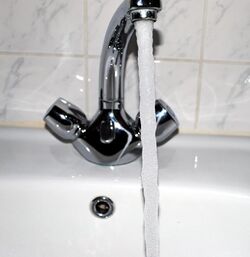Aeration
Topic: Physics
 From HandWiki - Reading time: 3 min
From HandWiki - Reading time: 3 min
Aeration (also called aerification or aeriation) is the process by which air is circulated through, mixed with or dissolved in a liquid or other substances that act as a fluid (such as soil). Aeration processes create additional surface area in the mixture, allowing greater chemical or suspension reactions.
Aeration of liquids
Methods
Aeration of liquids (usually water) is achieved by:
- passing air through the liquid by means of the Venturi tube, aeration turbines or compressed air which can be combined with diffuser(s) air stone(s), as well as fine bubble diffusers, coarse bubble diffusers or linear aeration tubing. Ceramics are suitable for this purpose, often involving dispersion of fine air or gas bubbles through the porous ceramic into a liquid. The smaller the bubbles, the more gas is exposed to the liquid increasing the gas transfer efficiency. Diffusers or spargers can also be designed into the system to cause turbulence or mixing if desired.
Porous ceramic diffusers are made by fusing aluminum oxide grains using porcelain bonds to form a strong, uniformly porous and homogeneous structure. The naturally hydrophilic material is easily wetted resulting in the production of fine, uniform bubbles.[1]
On a given volume of air or liquid, the surface area changes proportionally with drop or bubble size, the very surface area where exchange can occur. Utilizing extremely small bubbles or drops increases the rate of gas transfer (aeration) due to the higher contact surface area. The pores which these bubbles pass through are generally micrometre-size.
Uses of aeration of liquids
- To smooth (laminate) the flow of tap water at the faucet.
- Production of aerated water or cola for drinking purposes.
- Secondary treatment of sewage or industrial wastewater through use of aerating mixers/diffusers.[2][3]
- To increase the oxygen content of water used to house animals, such as aquarium fish or fish farm
- To increase oxygen content of wort (unfermented beer) or must (unfermented wine) to allow yeast to propagate and begin fermentation.
- To dispel other dissolved gases such as carbon dioxide or chlorine.[4]
- In chemistry, to oxidise a compound dissolved or suspended in water.
- To induce mixing of a body of otherwise still water.
- Pond aeration.
Aeration of liquid solids
Aeration of soil
Aeration in food
Refers to the process in which air is absorbed into the food item. It refers to the lightness of cakes and bread, as measured by the type of pores they contain, and the color and texture of some sauces which have incorporated air bubbles.
In wine tasting, a variety of methods are used to aerate wine and bring out the aromas including swirl wine in the glass, use of a decanter to increase exposure to air, or a specialized wine aerator.
Cider from Asturias is poured into the glass from a height of about 1 metre (el escanciado) to increase aeration.
See also
References
- ↑ Porous Ceramic Diffusers
- ↑ "Aeration". http://www.rpi.edu/dept/chem-eng/Biotech-Environ/AERATION/aeration.htm.
- ↑ "Aeration Device". Fortrans. http://fortransaeration.com/new-aeration-device-works-better/.
- ↑ Swistock, Bryan. "Methane Gas and Its Removal from Wells in Pennsylvania". PSU. http://extension.psu.edu/natural-resources/water/drinking-water/water-testing/pollutants/methane-gas-and-its-removal-from-wells-in-pennsylvania.
 |
 KSF
KSF
